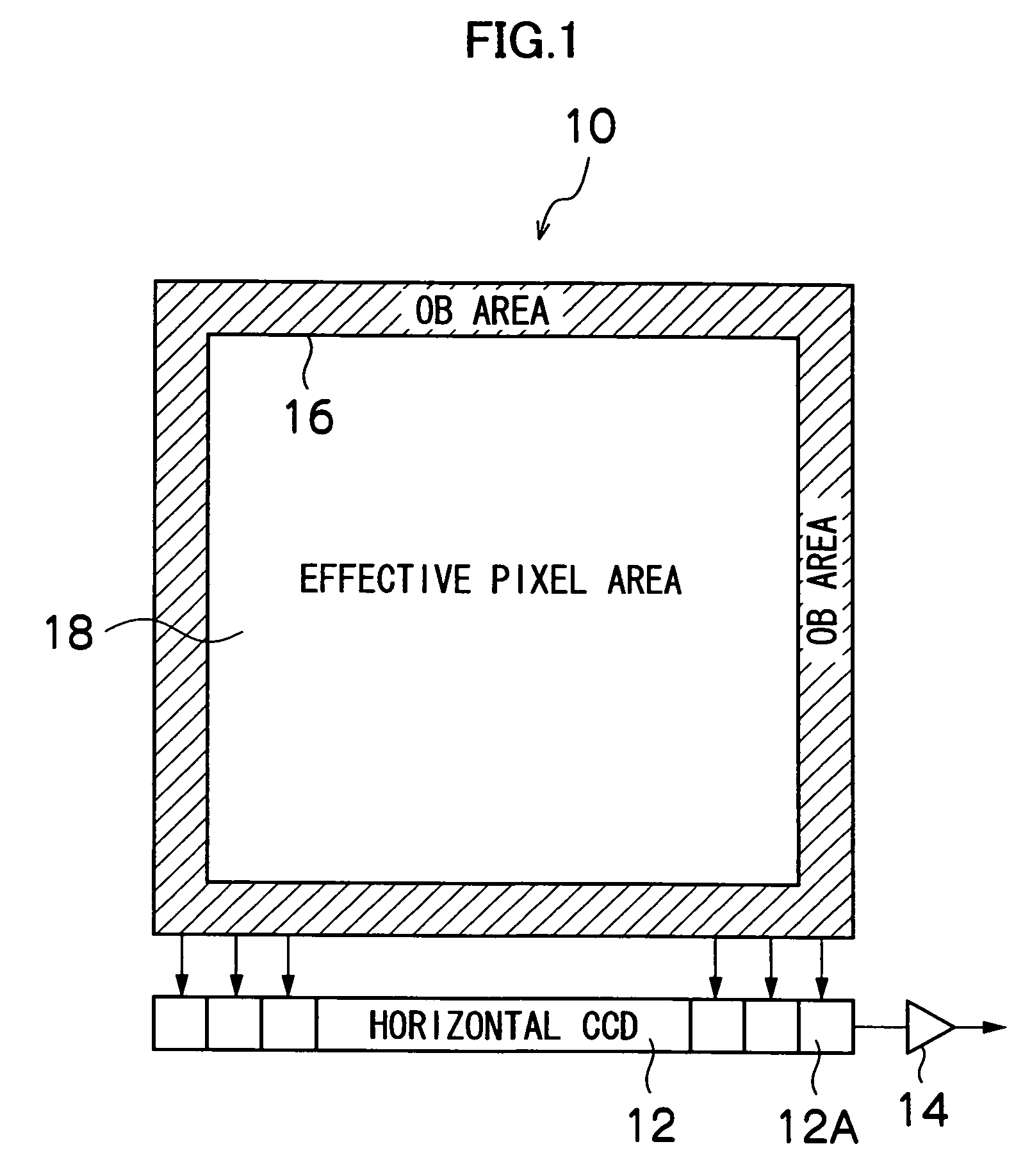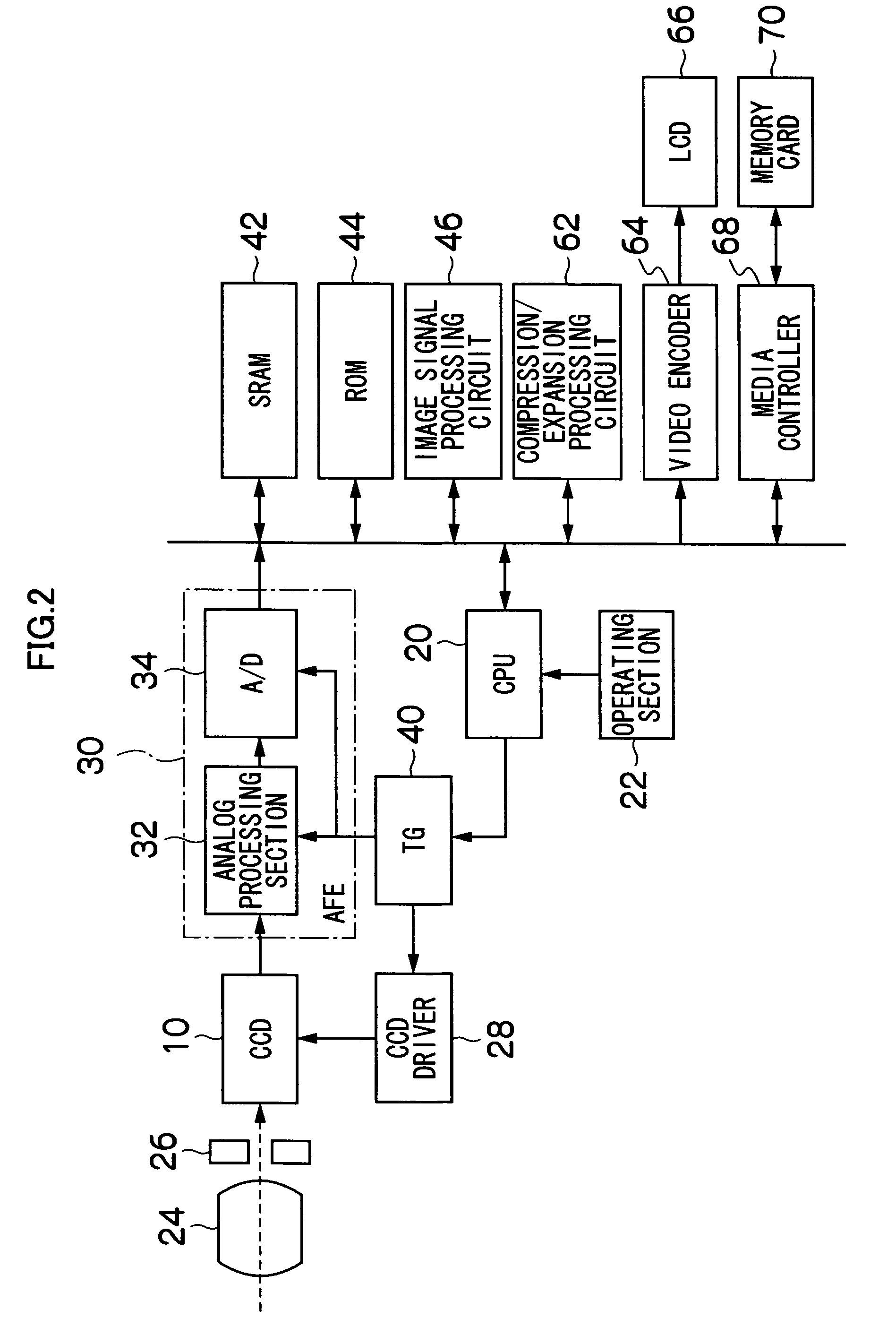Imaging apparatus
a technology of smear correction and apparatus, applied in the field of smear correction technique, can solve the problems of reducing the accuracy of photometry and color measurement, blown highlights, and smear-shaped noises or darkened screens, and achieve the effects of reducing analog gain or iso sensitivity, reducing the influence of smear, and improving image quality
- Summary
- Abstract
- Description
- Claims
- Application Information
AI Technical Summary
Benefits of technology
Problems solved by technology
Method used
Image
Examples
first embodiment
[0062]The above-mentioned smear correction circuit 48 will now be described. FIG. 4 is a block diagram showing a smear correction circuit according to a first embodiment of the present invention.
[0063]A smear correction circuit 48-1 shown in FIG. 4 comprises an adder circuit 100, a line memory 102, a memory controller 104, an OB position detection counter 106, a divider circuit 108, a smear detection circuit 110, a smear correction value calculation circuit 112, a smear occurrence position storage circuit 116, and a subtraction circuit 114.
[0064]The adder circuit 100 is arranged so that 8-bit data among the 12-bit CCD-RAW data from the AFE 30 is inputted thereto. The 8 bits are, for example, low-order 8 bits of the 12 bits. However, the low-order 8 bits need not be the first to eighth low-order bits, and for instance, may instead be the third to tenth low-order bits. This is because the characteristics of the smear signal allow compression to be performed on an area which does not r...
second embodiment
[0079]A second embodiment of the present embodiment will now be described. FIG. 8 is a block diagram showing a smear correction circuit according to the second embodiment of the present invention. In the following description, the same components as in the first embodiment shown in FIG. 4 are designated by the same reference numerals, and detailed description thereof will be omitted.
[0080]A smear correction circuit 48-2 shown in FIG. 8 comprises an adder circuit 100, a line memory 102, a memory controller 104, an OB position detection counter 106, a divider circuit 108, a smear detection circuit 110, a smear correction value calculation circuit 112, a smear occurrence position storage circuit 116, a subtraction circuit 114, and a smear occurrence proportion calculation / storage circuit 118.
[0081]The smear occurrence proportion calculation / storage circuit 118 is a device which calculates and stores a proportion of the smear occurrence area to the entire effective pixel area (smear occ...
third embodiment
[0087]A third embodiment of the present embodiment will now be described. FIG. 10 is a block diagram showing an image signal processing circuit according to the third embodiment of the present invention. As shown in FIG. 10, an image signal processing circuit 46 comprises a smear correction circuit 48, a black level correction circuit 50, a white balance adjustment circuit 52, a gamma correction circuit 54, a YC conversion circuit 56, a contour correction circuit 58 and a color-difference matrix circuit 60, and further comprises a photometric area specification section 72.
[0088]FIG. 11 is a flowchart for illustrating a flow of processing of a smear correction method according to the third embodiment of the present invention. First, when data (CCD-RAW data) is inputted from the AFE 30, determination is made on whether the data is related to an OB area (step S50). If it is determined that the data relates to an OB area, an average value of all the data of the OB area (average OB value...
PUM
 Login to View More
Login to View More Abstract
Description
Claims
Application Information
 Login to View More
Login to View More - R&D
- Intellectual Property
- Life Sciences
- Materials
- Tech Scout
- Unparalleled Data Quality
- Higher Quality Content
- 60% Fewer Hallucinations
Browse by: Latest US Patents, China's latest patents, Technical Efficacy Thesaurus, Application Domain, Technology Topic, Popular Technical Reports.
© 2025 PatSnap. All rights reserved.Legal|Privacy policy|Modern Slavery Act Transparency Statement|Sitemap|About US| Contact US: help@patsnap.com



